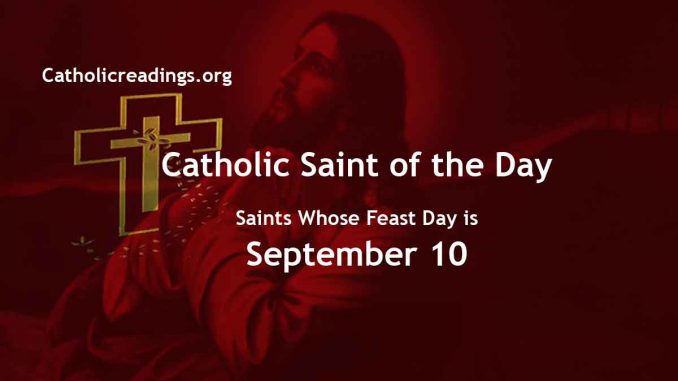This is the Saint of the Day list of Saints and Blesseds whose feast day is September 10 2025.
👉 Saint Nicholas of Tolentino
Saint Ambrose Edward Barlow
Saint Pulcheria
Saint Finnian of Moville
Blessed Jacques Gagnot
Saint Theodard of Maastricht
Beata Vergine Maria della Vita
Saint Peter Martinez
Saint Nemesius of Alexandria
Blessed Ogerius
Saint Autbert of Avranches
Saint Sosthenes of Chalcedon
Saint Victor of Chalcedon
Saint Frithestan
St Frithestan was also known as Frithustan. He was the spiritual student of St Grimbald. He was the bishop of Winchester, England who was consecrated by St Plegmund. He served for 23 years, and noted for his care for the poor and a ministry of prayer for the recently dead. He died in 933 AD.
Saint Agapius of Novara
St Agapius of Novara was also known as Agabio, Agapitus, and Agapio. He served as the Bishop of Novara, Italy for 30 years from 417 AD. He died in 447 AD.
Saint Barypsabas
St Barypsabas was a first-century hermit. There is a legend that says that Barypsabas carried a container of the blood that flowed from the side of Jesus Christ when He was pierced on the cross, during his pilgrimage to Rome, Italy, He was martyred in Dalmatia.
Saint Veranus of Vence
St Veranus of Vence was also known as Veran or Weran. He was the son of Galla, a woman who became a nun in her later life, and Saint Eucherius of Lyon. He became a monk at Lérins, France, and later the Bishop of Vence, France. He died in 480 AD.
Saint Salvius of Albi
St Salvius of Albi was also known as Salvio. He was a lawyer, a monk, an abbot, a hermit, and the Bishop of Albi, France in 574 AD. He died during an epidemic while tending the sick in 584 AD.
Saint Clement of Sardis
St Clement of Sardis was a convert in the first century. He was one of the original 72 missionaries sent by Jesus himself. Bishop of Sardis. He died as a martyr.
Saint Candida the Younger
St Candida the Younger was a laywoman who was married and a mother in Naples, Italy. She died in 586 AD.
Martyrs of Bithynia
The Martyrs of Bithynia are three young Christian sisters martyred in 306 AD in Bithynia, Asia Minor in modern-day Turkey during the persecutions of emperor Maximian and governor Fronto.
Their names are;
- Menodora
- Metrodora
- Nymphodora
205 Martyrs of Japan
The 205 Martyrs of Japan are the 205 missionaries and native Japanese who were killed between 1617 AD and 1637 AD because of their faith. A unified feast to memorialize all of them is held today.
Martyrs of Sigum
The Martyrs of Sigum are a group of Nicomedian martyrs who in 257 AD were condemned for their faith and overworked to death in the marble quarries of Sigum.
They were a mixture of priests, bishops, and laity.
Some of their names are;
- Dativus
- Felix
- Jader
- Litteus
- Lucius
- Nemesian
- Polyanus
- Victor
Martyrs of the Spanish Civil War
These are the names of some of the thousands of people who were murdered from 1934 to 1939, during the anti-Catholic persecutions of the Spanish Civil War.
Their names are;
- Blessed Leoncio Arce Urrutia
- Blessed Félix España Ortiz
- Blessed Tomàs Cubells Miguel

Related Links
Powered By SEO Experts
Follow @ReadingCatholic
